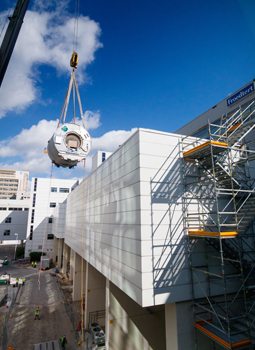Froedtert & The Medical College of Wisconsin
Wauwatosa
Innovation: Cutting-edge cancer imaging and radiation therapy delivery system.
www.froedtert.com/cancer
An installation crew recently used a crane to hoist a massive cylindrical tube and metal ring above Froedtert & the Medical College of Wisconsin’s Clinical Cancer Center and lower the pieces of equipment into one of the hospital’s heavily-insulated radiation therapy vaults.
The equipment is part of a new imaging system to guide radiation therapy in cancer patients called an MR-guided linear accelerator, or MR-linac. It’s a brand new technology that combines Magnetic Resonance Imaging, MRI, with a linear accelerator — a system used during radiation therapy to shoot damaging X-rays at cancer cells.

Froedtert & MCW physicians and researchers are hoping the technology will help them develop groundbreaking cancer treatment techniques that are more effective and more precise than current methods. They’re also hoping it will provide treatment data that will inform radiation therapy innovations for years to come.
Froedtert & MCW is one of only seven sites around the world that will install an MR-linac system over the next couple of years. In 2013, it was selected by the manufacturer, Stockholm, Sweden-based Elekta, to be part of a global consortium of hospital systems that will provide input during its development phase. Now that the technology has been developed, Froedtert & MCW will test its capabilities through clinical trials over the next few years.
Four other sites already have installed the new technology: The Netherlands Cancer Institute; the University Medical Center Utrecht in the Netherlands; the MD Anderson Cancer Center at the University of Texas in Houston; and the Institute of Cancer Research in London.
The system, which combines two tools frequently used during radiation therapy, eventually will allow doctors to capture real-time images of tumors and surrounding tissues during radiation therapy.
Dr. Christopher Schultz, a Medical College of Wisconsin professor and chairman of Froedtert & MCW’s Department of Radiation Oncology, said the new capabilities will eliminate a lot of guesswork during radiation treatment.
He compared using the MR-linac instead of current treatment methods — which involve using a combination of MRI and CT scans to map out treatment plans — to using a rifle as opposed to a shotgun. In other words, he believes it has the potential to deliver far more precise treatment for patients with certain tumors that could decrease the number of radiation sessions they require and reduce the physical toll radiation therapy can take on a patient’s body.

“Sometimes, the tumor changes or the patient loses weight and we have to modify the treatment plan sort of from scratch, but it hasn’t been practical to do that until recently,” Schultz said. “Our overarching goal is to be able to do image-guided and adaptive radiation therapy. If we can see the tumor better and if we can avoid the normal tissue better, that will allow us to actually increase the dose to a tumor that we can’t do now because we’re not avoiding the surrounding tissues. So there’s an opportunity for dose escalation.”
Schultz said that for many cancerous tumors, there is what he called a “dose response curve,” which says the higher the dose of radiation a physician is able to shoot at a tumor, the greater probability it will be reduced in size or destroyed. But right now, a physician’s ability to increase doses to certain levels is limited since current imaging technology makes it difficult to avoid hitting some healthy tissue while delivering radiation therapy.
Theoretically, the MR-linac will improve a physician’s ability to limit the exposure of healthy tissue to damaging X-rays during cancer treatment, and maximize the exposure of cancerous tumors to the treatment.
“While we already have significant evidence supporting the potential of MR-linac, fully realizing its practical applications will require rigorous evaluation in real-world clinical settings,” said Dr. J. Frank Wilson, a radiation oncologist and professor of radiation oncology with Froedtert & MCW Cancer Network. “Initially, we will focus on establishing clinical protocols and refining methods for data collection and analysis in pancreatic cancer, a deadly disease with limited treatment options. We are optimistic that MR-linac will be a critical advancement in patient care and ultimately, improve outcomes in this and other types of cancers.”
Over the next few years, Froedtert & MCW researchers and physicians will work with members of the MR-linac consortium assembled by Elekta to establish clinical protocols for using the imaging system and also methods for data collection and analysis. The researchers also will collaborate with other members of the global consortium testing the technology to decide which types of cancer the MR-linac is best suited to treat.

